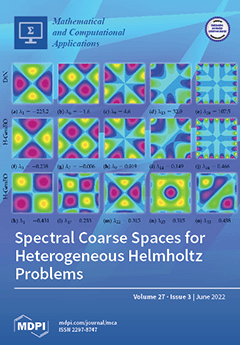, the largest small polygon with
vertices, is a polygon with a unit diameter that has a maximal of area
. It is known that for all odd values
[...] Read more.
, the largest small polygon with
vertices, is a polygon with a unit diameter that has a maximal of area
. It is known that for all odd values
,
is a regular
-polygon; however, this statement is not valid even for values of
. Finding the polygon
and
for even values
has been a long-standing challenge. In this work, we developed high-precision numerical solution estimates of
for even values
, using the Mathematica model development environment and the IPOPT local nonlinear optimization solver engine. First, we present a revised (tightened) LSP model that greatly assists in the efficient numerical solution of the model-class considered. This is followed by results for an illustrative sequence of even values of
, up to
. Most of the earlier research addressed special cases up to
, while others obtained numerical optimization results for a range of values from
. The results obtained were used to provide regression model-based estimates of the optimal area sequence
, for even values
of interest, thereby essentially solving the LSP model-class numerically, with demonstrably high precision.
Full article





